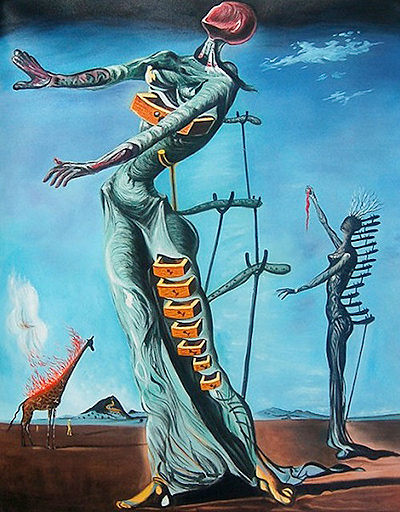The emergence of psychoanalysis and the work of Sigmund Freud were major influences on the artist, along with the cubist output of Picasso and the work of other surrealists, such as, Miro and classical painters,including Vermeer and Velazquez.
Those coming to Dali for the first time, most typically through the coloured plates in art books, are often surprised to find that the actual canvases and boards he committed his work to are much smaller than imagined. The Burning Giraffe is one such example.
The work dates from 1937 when Dali was 34 years old. It was painted in Spain, with oils on board, prior to Dali’s American sojourn in the early 1940s. The painting measures 35cm X 27cm and is currently housed in the Kunstmuseum in Basel Switzerland.
In 1937, Spain was in the grip of a bloody civil war and the painting is thought to represent both the insecurities the artist felt about that conflict, his struggles with his own country and his own deeper subconscious world of dreams, and perceptions. It is full of images that act almost as motifs which recur frequently in Dali’s work.
It is interesting that the title of the painting is The Burning Giraffe because this image, which is much smaller than the two female forms in the foreground, can only be seen, almost in relief, at the back of the picture as the eye moves back towards the horizon.
Dali first used the image of a burning Giraffe, which he called the masculine cosmic apocalyptic monster, in the film L’ Age d ‘Or (the Golden Age) which he made in collaboration with Luis Bunuel in 1930.
The image recurs again in a much later (1975) work in pastel and water colour, Burning Giraffes in Brown, also known as Giraffe Avignon. For many, the Giraffe works for Dali as a totem animal with the burning Giraffe seen as a premonition of war; whilst fire is representative of a dangerous death, imbued with meaning.
The breaking up of the female form and mystification surrounding female sexuality, combined with fetishism are themes common to Dali. Here the two main figures are clearly female, but they appear in almost skeletal form as what Dali called, the tail bone woman.
The skin appears to be peeling, exposing what lies beneath, hidden, one of the main ideas conveyed in this work. The figures stand in isolation from each other and from the rest of the painting, in a dream landscape which the artist has created by exceptional use of colour.
The figures are featureless, deprived of sight or hearing but the figure in the foreground is reaching out for something, perhaps symbolic of the position women had reached on their journey towards equality.
The drawer that opens out of the thorax, together with the seven small drawers that open from the left leg of the principle figure, make what Dali referred to as the anthropomorphic cabinet. This takes us back to Freud and the secret drawers in the human psyche which can only be opened through psychoanalysis.
From Dali's perspective this was about suppression of the inner and subconscious life, and the taming of inner beast.
Women are objectified and desired and this is repressed and the true self is hidden away because these things are not socially acceptable. And yet, Dali was aware of what he called, the narcissistic smells coming from the drawers which made it almost impossible to resist opening them.
Undefined shapes eminate from the backs of both of the female forms. Could these shapes be yet another of Dali’s favourite artistic devices, melting clocks, or soft watches as seen in perhaps his most famous work, The Persistence of Memory (1931)?
The smaller figure holds what appears to be a piece of flesh in her hand, a device also present in The Great Masturbator (1929). Raw meat is seen as the call for a return to primitive nature, a rediscovery of the inner being.
Both female forms are supported by crutches, yet another of Dali’s common motifs seen in many of his works, but perhaps best utilised in Sleep (1937) and less so in The Ghost of Vermeer of Delft Which Can Be Used As a Table (1934).
In The Burning Giraffe, the crutches are clearly masculine in nature, representing a patriarchal system which many believed women would be helpless without. They are phallic in essence, male dominance over the bodies of women.

